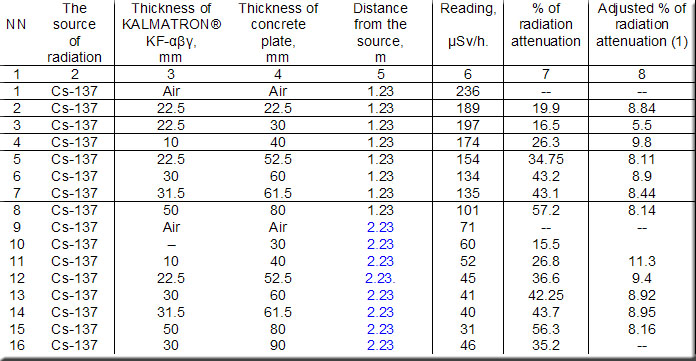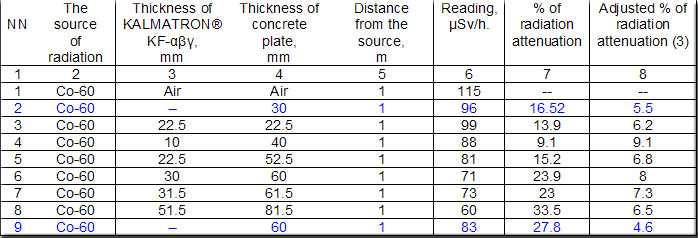Effective Radiation Shielding Material with ability to be safely applied by plaster technology has the highest priority in the building, protection and repair of the nuclear industry related facilities. The most known of them is KALMATRON® KF-αβγ.
After extensive testimonies in the different countries KALMATRON® KF-αβγ became a leading product in the fields of radiation protective coatings, additives to the cementitious mixes, and also uses as powder by itself strewed into the source of radiation pollution. Another effective field of application is radiation attenuation of the natural dust, ash, soil, etc. by premix with the powder of KALMATRON® KF-αβγ.
On the charts below shown comparative measurements of radiation attenuation by Aluminum, Steel, Lead, Concrete and coating of KF-αβγ on the concrete specimen. High effectiveness and simplicity of KF-αβγ application are shown below, proved by numerous test results from Russia, Taiwan and China.
CENTRAL INSTITUTE OF ACADEMIC A.A. BOCHVARA
“Evaluation of radiation shielding properties of radiation reflecting material KALMATRON KF-αβγ”
Deputy of General Engineer: V.F. Derzhavin. Moscow 2002
The research has been done in accordance with agreement at 04. February 2002 N 4/2002 between “CENTRAL INSTITUE OF ACADEMIC A.A. BOCHVARA” (contractor) and LTD “Kalmatron -M” (client).
1. Preparation of specimens
For evaluation of radiation shielding properties of KALMATRON® KF-αβγ the manufacturer supplied standard material which is dry cementitious mix of KALMATRON® KF-αβγ at 60 Kg (by 20 Kg in each bucket). The delivery was provided in a special package. In accordance with recommendations of KALMATRON Corporation, it is a necessity:
- evaluate the thickness of the layer that enough for protection. That requirement provided by comparative measurements with imitation of real conditions.
- Prepare the surface of concrete (by wetting of surface with water).
The quality of properties evaluation depends on the following of the method of specimens preparation. Mr. V. A. Yakovlev as a representative of client provided control of two stages:
- preparation of equipment,
- preparation specimens.
2. Preparation of equipment
2.1 The mold for preparation of concrete specimens was made from 10 mm thick wooden plates and inside size at 250 x 250 (mm). A few such identical molds with different depths of molds were made (for comparative evaluation of shielding properties of tested KALMATRON® KF-αβγ).
2.2 Preparation of KALMATRON® KF-αβγ specimens. The molds were placed on a smooth metal surface or on a wetted surface of concrete plate 30 mm thick. The thickness of KALMATRON® KF-αβγ layers were designed at 10, 20, 30 mm. After preparations all specimens were stored in an air humid environment and only after that were tested.
3. Evaluation of radiation shielding properties of KALMATRON® KF-αβγ
Evaluation of radiation shielding properties was provided with two sources of radiation Co-60 and Cs-137 with number N 449 and N992. The measurements were provided by apparatus UPGD -2 – “ruler”, which allows to control the distance between the source of radiation and tested specimens.
4. The method of the experiment
As it was observed above (chapter 1) the standard specimens such as made with KALMATRON® KF-αβγ by itself, concrete plate and concrete plate coated with KALMATRON® KF-αβγ layers were used for tests. Besides of it, some another materials were tested also.
4.1. The results of measurements
The measurements were provided at a distance of 1 m and about 2 m from the source of radiation. Dosimeter MKS-01P with indicator BDKB 01P were applied also. The indicator was placed closely to the specimen and just behind specimen. At 5 to 7 readings were taken from every specimen ( statistically balanced data shown in a table 1). The collimator supplied with a canal that controls direction of radiation stream when it was opened. The radiation stream is targeted to the specimen that placed on operational cart. The distance between source and specimen was registered (detected) by the rails.
On the charts below shown adjusted percentage of radiation attenuation calculated by dividing of the test readings by 10 (except readings of concrete plate, i.e. after extraction of concrete plate readings from total one, the reminder was divided by 10). This calculation is determined to show linear correlation of radiation attenuation with tested specimen and the source of radiation.
5. Conclusions and recommendations
5.1. As it shown in the table 1 and the table 2, that application of KALMATRON® KF-αβγ gives positive results for attenuation of radiation. Moreover, the
analyzes of readings from column 8 shows that adjusted percentage of radiation attenuation is close to the permanent level (for the thickness of
10mm in our experiments). For instance, adjusted percentage of radiation attenuation for Cs-137 from table 1 is 8.775 (for distance from source at 1 m).
5.2. It has been proven, that readings for KALMATRON® KF-αβγ are higher (better) by at 1.23 to 1.6 times than concrete and by 1.5 times than for
compared Aluminum plate.
5.3. Since radiation attenuation of KALMATRON® KF-αβγ layers are significantly exceeds concrete it was recommended to use product for building and
repair of structures for protection of environment and biological objects from radiation penetration.
The Head of Department
A.Y. Chylykin.
Moscow 2002








